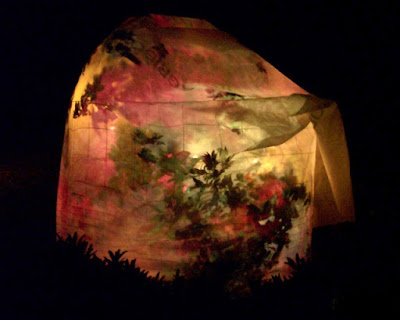Old-style incandescent Christmas lights can help citrus trees during a freeze, providing up to 4 degrees of protection. A frost blanket can give tender plants
4 to 8 degrees of protection. (Photo: Kathy Morrison
)
Get ready for frost and heavy rain
Keep your mittens and your umbrella handy. After a relatively dry and warm early December, our weather is about to feel a lot like winter.
Sacramento got its first touch of frost early Friday morning. Most neighborhoods stayed above 34 degrees but temperatures are expected to drop a little more tonight.
“Some frost and near-freezing temperatures were observed across our area this morning,” tweeted the Sacramento office of the National Weather Service on Friday morning. “Similar conditions are possible tomorrow.”
The weather service gave Sacramento a 38% chance of dipping below 32 degrees before dawn Saturday. Grass Valley has a 40% chance of freezing overnight temperatures.
While flirting with frost is common in December, big snowmakers have been rarer in recent years. Starting Saturday night, an atmospheric river is expected to churn its way through Northern California. Several feet of snow are forecast for the Sierra with “difficult to impossible travel conditions,” says the weather service.
With day and overnight temperatures in the 40s, the Valley will see cold rain through Tuesday – perhaps 2 to 4 inches in Sacramento. After a very dry November, that’s great news for water watchers. Historically, December averages 3.25 inches in Sacramento. We could get the whole month’s worth of precipitation in three days.
In addition to the rain, expect high winds with gusts of more than 30 mph.
Take time before the storm to protect frost-sensitive plants as well as plants sensitive to too much cold rain. Poinsettias, in particular, don’t like frost and can’t stand cold rain. Bring them inside until the storm passes.
Harvest ripe citrus now instead of waiting until after the storm. Limes are most frost-tender, but very cold rain also can be problematic for citrus. Navel oranges on a mature tree should be fine unless temperatures drop into the lower 20s; cold makes them sweeter. If you think they're ripe, taste one before harvesting more.
Succulents, cacti and tropical plants such as hibiscus and banana are threatened by both frost and cold rain. They prefer to stay on the dry side and protected from extreme cold; too much rain, they’ll rot.
Here are more weather-related winter tips:

|
|
This plant is protected from frost with frost cloth and lights -- and
it looks festive, too. (Photo courtesy UC Sacramento County
master gardeners)
|
* If frost is in the forecast (like tonight), cover your sensitive plants with frost cloth, blankets or cloth sheets (not plastic) before sunset so radiant heat will help keep them cozy.
* Remember to uncover plants during the day (especially if it’s sunny) or they can be smothered by their frost protection. Don’t leave frost cloths over plants during rain.
* Wrap trunks of young citrus trees to insulate them from frost.
* Holiday lights – the old-fashioned kind that get hot, not LEDs – can help keep plants warm, too. Wrap a string of lights around the trunk and branches. Keep the lights on all night.
* Don’t overprotect. Plants are more frost-resistant if they’ve experienced some cold weather and winter hardening.
* With some exceptions, keep plants watered. Frost injury occurs when ice crystals form on leaf surfaces and draw moisture out of the leaf. The damage from dehydration is what causes frost burn.
* If frost damage occurs, wait until March or April to prune off browned branches. That injured area will help protect the rest of the plant from further frost burn.
